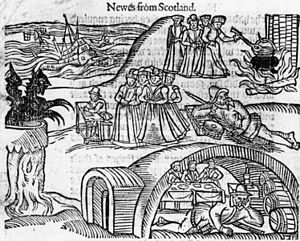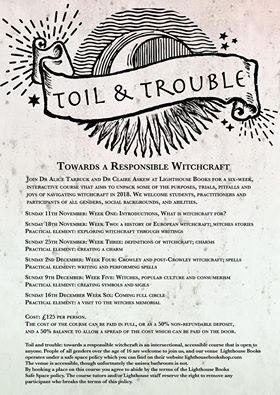Scotland is a witch-ridden country. James VI knew this, when he wrote Daemonologie, his treatise on witchcraft and its evils in 1597. Six years prior, they had burned the North Berwick witches, who were tortured into confessing their part in a plot to drown King James and his Danish bride, Princess Anne, at sea. These were the first witch trials held in Scotland.

Scottish witchcraft is, in part, a product of Scottish landscape and culture. Our rural landscapes, and dispersed communities mean that many pre-Christian traditions have survived, in various forms. Our Hogmanay traditions of first-footing, for example, are a small form of magic.
To bring coal, bread and whiskey to a neighbour’s house is to make a charm, for heat, food and good cheer in the coming year. The same is true of redding the house – to invite the new year in, you must clean thoroughly – otherwise luck will not stay in the house. These traditions are very much practical witchcraft.
Additionally, many Scottish customs come from a blending of pre-Christian and early-Christian traditions. For example, the healing stones at St Fillan’s Mill in Killin, which are still in use, are part of ancient traditions of sympathetic medicine. In the tradition of sympathetic medicine (often described as a form of witchcraft or folk healing) healing is thought to occur when magical objects shaped like the affected body part are placed on that body part. These objects might be plants, branches, fruit or vegetables – but usually they are something more durable. St Fillan’s stones are eight stones, shaped like internal organs, which are still used in healing. St Fillan, of whom little is known, was an early Christian saint, and the stones are believed to predate him.
These two traditions have lasted into contemporary Scottish culture, alongside numerous others. These include festivals, like those held by Edinburgh’s Beltane Fire Society, which celebrates, through large-scale public events, the Celtic lunar calendar’s fire festivals. These events, whilst attended by a crowd of both secular and practicing individuals, are spiritual in nature, celebrating pre-Christian understandings about the nature of the struggle between light and darkness. These beliefs, and the images therein, are centred around solstice points in the year. The Beltane Fire Society’s festivals reconnect participants and audiences with ancient myths, and with the cyclical nature of the world’s turning, and these pagan rituals form a vibrant part of Scotland’s contemporary pagan/witchcraft scene.

There are also focused groups of practicing witches, and of course, shops which offer magical paraphernalia. In particular, the internet has connected witches across Scotland and the world, and thriving Facebook groups offer meetups, as well as information to budding Scottish witches. Shops, like the Wyrd Shop in Edinburgh, are hubs for information and equipment. Scottish witchcraft and pagan traditions are truly alive and well, and even though the current resurgence of interest in witchcraft makes witchcraft feel more visible, they have always been there.
However, witchcraft, whether formalised into Wicca or more freely practiced, tends to be a largely private affair. Although it does not attract the same stigma that it did in the medieval period, there is still a social stigma around the sincere practicing of witchcraft, and a sense that witches are somehow outside the ordinary, unlike other people. Covens provide an opportunity to discuss and practice witchcraft, and there are an increasing number of conferences, for example, those organised by the Pagan Federation of Scotland. Generally speaking, however, as it is not a formalised religion, witchcraft doesn’t offer the same opportunities as other spiritual practices for fellowship and group learning.
As witchcraft has once more become popular in media, more people are being attracted to practicing witchcraft without much research or grounding. Instagram is full of moody looking individuals holding crystals and posing with cobwebs, but this glamorous – and stereotypical – image of contemporary witchcraft has little in common with the reality. Not only is this glamorous image false, it has also been co-opted to sell goods. Sephora and other large chain stores are selling beginner ‘witch kits’, which contain items like white sage for smudging. Smudging is a practice indigenous to first nation people’s of North America, and to sell it to (predominantly young, white) women is to appropriate a sacred practice. The crystals, too, have no certificate of origin, and many crystals are mined using exploitative and unsafe labour practices.
To highlight these unethical practices is not to blame the people buying these kits – but it is important to point out the gaps in knowledge that can occur when shops co-opt witchcraft paraphernalia for money.

It is into this gap in occult knowledge that Dr. Claire Askew and I hope to step. Dr Claire Askew is a poet and novelist, and her writings on historical women accused of heresy and witchcraft have been published by The Dangerous Women Project, The Scottish Review of Books and Amelias Magazine, among others.
Together, we have designed a six week course that aims to to unpack some of the purposes, trials, pitfalls and joys of navigating witchcraft in 2018. We will teach people about the real, historical women accused of heresy and witchcraft during the European Witchcraft Hysteria, and look at the contribution of the witch in folklore and popular culture to our modern understanding of magic and personal power. We are also keen to help participants consider the ways in which we can create and engage with a more responsible witchcraft: one which welcomes students, practitioners and participants of all genders, social backgrounds, and abilities. From responsible foraging to making charms, from learning of global magic cultures to paying tribute to the North Berwick witches, Toil and Trouble: Towards a Responsible Witchcraft will run from Sunday 11th November to Sunday 16th December, at Lighthouse Books in Edinburgh.
Hopefully, this course will form a vital and fascinating part of Scotland’s vibrant and historied witchcraft scene!
All of the details of the course can be found at: https://toilandtrouble.brownpapertickets.com/

Dr Alice Tarbuck is the author of Grid (Sad Press, 2018), and an academic working at the University of Dundee and the Centre for Poetic Innovation. Her work on witchcraft has been featured in 404 Inks Nasty Women, The Dangerous Women Project, Edinburgh Universitys Uncanny Bodies project, and the Fiction and Feeling project. She has been invited to speak on witchcraft as feminist practice by Scottish PEN and is currently planning a longer work on witchcraft and contemporary practice. Additionally, she has taught workshops for the National Library of Scotland, the Scottish Poetry Library and further afield. When she was born, a white wizard came to her house to bless her, and this, she suspects, is where the trouble started.